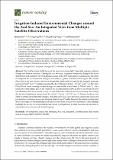Irrigation-Induced Environmental Changes around the Aral Sea: An Integrated View from Multiple Satellite Observations
Author(s)
Jin, Qinjian; Wei, Jiangfeng; Yang, Zong-Liang; Lin, Peirong
Downloadremotesensing-09-00900.pdf (3.906Mb)
PUBLISHER_CC
Publisher with Creative Commons License
Creative Commons Attribution
Terms of use
Metadata
Show full item recordAbstract
The Aral Sea basin (ASB) is one of the most environmentally vulnerable regions to climate change and human activities. During the past 60 years, irrigation has greatly changed the water distribution and caused severe environmental issues in the ASB. Using remote sensing data, this study investigated the environmental changes induced by irrigation activities in this region. The results show that, in the past decade, land water storage has significantly increased in the irrigated upstream regions (13 km 3 year -1 ) but decreased in the downstream regions (-27 km 3 year -1 ) of the Amu Darya River basin, causing a water storage decrease in the whole basin (-20 km 3 year -1 ). As a result, the water surface area of the Aral Sea has decreased from 32,000 in 2000 to 10,000 km2 in 2015. The shrinking Aral Sea exposed a large portion of the lake bottom to the air, increasing (decreasing) the daytime (nighttime) temperatures by about 1 °C year -1 (0.5 °C year -1 ). Moreover, there were other potential environmental changes, including drier soil, less vegetation, decreasing cloud and precipitation, and more severe and frequent dust storms. Possible biases in the remote sensing data due to the neglect of the shrinking water surface area of the Aral Sea were identified. These findings highlight the severe environmental threats caused by irrigation in Central Asia and call attention to sustainable water use in such dryland regions. Keywords: environmental issues; the shrinking Aral Sea; irrigation; desertification; dust storm; remote sensing; NDVI; GRACE; MODIS
Date issued
2017-08Department
Massachusetts Institute of Technology. Center for Global Change ScienceJournal
Remote Sensing
Publisher
MDPI AG
Citation
Jin, Qinjian et al. “Irrigation-Induced Environmental Changes Around the Aral Sea: An Integrated View from Multiple Satellite Observations.” Remote Sensing 9, 12 (August 2017): 900 © 2017 Authors
Version: Final published version
ISSN
2072-4292